Counts of Montfort (Swabia)
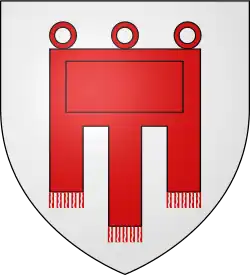
The Counts of Montfort were an ancient German noble dynasty from Swabia. They belonged to high nobility of the Holy Roman Empire and enjoyed the privileged status of Imperial immediacy.
The influential and wealthy counts of Montfort took their name from an ancestral castle named Montfort, which was situated close to today's Swiss border near Weiler, in the present-day Austrian state of Vorarlberg.
As the lords of Feldkirch (until 1390), Bregenz (until 1523), and Tettnang (until 1779), they would have a decisive influence on the development of not just Vorarlberg, but also Upper Swabia and Eastern Switzerland.
History
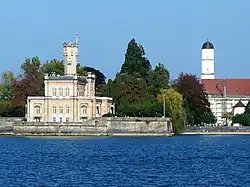
The counts held the lordships of the County of Feldkirch (until 1390), County of Bregenz (until 1523) and Tettnang (until 1779). They had territories in Upper Swabia and particularly in Vorarlberg, most of which they ruled. Until the 18th century, the counts were a remarkable family of the high nobility, the most important in the region of Lake Constance, but the line eventually became extinct. In a number of places, including Feldkirch, Bregenz and Langenargen, there are still signs of their history.
The counts of Montfort were originally a branch of another Swabian noble family, the counts palatine of Tübingen. Hugo II of Tübingen (d. 1182) married Elizabeth of Bregenz, and through her, Hugo would take ownership over the former territories of the counts of Bregenz, including Bregenz itself, Montfort, and Sigmaringen, making him a dominant power in the region. His marriage to Elizabeth would also provide him with close family ties to Emperor Frederick I Barbarossa and the Welfs (like Barbarossa and Henry the Lion, Elizabeth was a grandchild of the Welf duke Henry IX of Bavaria).
Upon the death of Hugo II, the majority of the former Bregenz territories would go to his second son, Hugo III (d. 1228/1230), who after about 1200 would style himself "Hugo of Montfort". His territories as count included Raetia Curiensis, Tettnang, Bregenz, Feldkirch, Sonnenberg, Werdenberg, and Sargans. The new House of Montfort would adopt the arms of the County Palatine of Tübingen, but the Montfort arms would feature a red gonfalon on a silver shield instead of a gold one.
Hugo's older brother Rudolph I (1160–1219) continued the original line of the counts palatine; nevertheless, five generations later Gottfried II (d. 1369) would be forced to sell Tübingen to the County of Württemberg and drop the title of count palatine in favor of the ordinary Count of Tübingen. He did, however, inherit Lichteneck via his wife Clara of Freiburg, and thenceforth his descendants would bear the title Count of Tübingen-Lichteneck. Next to Montfort-Tettang, this line would be the longest-lasting branch of the family, lasting until 1664.
Around 1779, Tettnang was sold to the Austrian House of Habsburg in order to pay debts. Several years later, the line became extinct upon the death of Count Anton IV in 1787. The Habsburgs added the Montfort lands to their Further Austrian possessions.
Montfort-Feldkirch
Hugo I of Montfort founded Feldkirch in the early years of the 13th century, building his castle (called Schattenburg) on a hill overlooking the town. The town and castle would become the focal point of the Montfort-Feldkirch territories, with Schattenburg taking the place of the original Montfort castle. In 1375, burgrave Rudolph IV of Montfort sold the fiefdom to the Habsburg Duke Leopold III of Austria.
Montfort-Bregenz
Hugo II of Tübingen (d. 1182) inherited the County of Bregenz via his wife, Elizabeth of Bregenz. The Montfort-Bregenz branch of the dynasty continued until the middle of the 14th century, when its lands fell to Montfort-Tettnang, which starting in 1354 would be known as Montfort-Tettnang-Bregenz. This house would produce at least one figure of historical significance, the minstrel (Minnesänger) and statesman Hugo von Montfort (1357–1423).
In 1362 Hugo inherited the lands of the counts of Pfannberg via his wife Margaret. Hugo took residence at Pfannberg Castle in 1401, joining the Styrian nobility. The family would sell Pfannberg Castle in 1524 and move their residence to Peggau Castle, renaming themselves Montfort-Bregenz-Beckach (the contemporary form of Peggau).
In 1451, a portion of the Montfort-Bregenz territory was sold to the Habsburgs by Elizabeth of Hochberg, heir of Count William VII (d. 1422) of Montfort. The rest of the original Bregenz territories would be sold in 1523, though the Styrian branch of the family retained the Montfort-Tettnang lands until the extinction of the dynasty in 1787.
Counts of Montfort
Below, a list of the counts of Montfort, numbered by order of ascension:
House of Tübingen
Partitions of Montfort under Tübingen rule
| County of Montfort (1208–1260) | |||||
| County of Feldkirch (1260–1375) |
County of Tettnang (1260–1520) |
County of Bregenz (1st creation) (1260–1338) | |||
| Sold to Austria | |||||
| County of Bregenz (2nd creation) (1353–1443) |
County of Pfannberg (1379–1524) Renamed County of Peggau (1524–1779) | ||||
| County of Rothenfels (1438–1576) |
County of Werdenberg (1438–1483) | ||||
| Sold to Austria | |||||
| County of Bregenz (3rd creation, half of previous county) (1482–1525) | |||||
| Sold to Austria | |||||
| Sold to Königsegg | |||||
| Sold to Austria | |||||
Table of rulers
(Note: Here the numbering of the counts is the same for all counties, as all were titled Counts of Montfort, despite the different parts of land or particular numbering of the rulers. The counts are numbered by the year of their succession.)
| Ruler | Born | Reign | Death | Ruling part | Consort | Notes | |
|---|---|---|---|---|---|---|---|
| Hugo I | 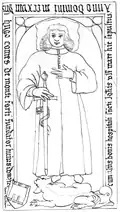
|
c. 1160 | 1208–1228 | 1228 or 12 March 1230 or 1234 | Montfort |
|
Son of Count Palatine Hugo of Tübingen, was the first count of Montfort, and the founder of the Montfort branch. |
| Hugo II | c. 1195 | 1228 – 1257 or 1260 | 11 or 15 August 1257 or 1260[1] | Montfort | Elisabeth of Burgau eight children |
Sons of Hugo I, ruled together until 1230, when Rudolph inherited Werdenberg. Henry became bishop at Chur in 1251. For Rudolph I's descendants, see Counts of Werdenberg. After Hugo's death the county was divided. | |
| Henry I | c. 1190 | 1228–1251 | 14 November 1272[2] | Montfort | Unmarried | ||
| Rudolph I | c. 1190 | 1228–1230 | September 1244, 7 October 1247 or 19 May 1248 | Montfort | Clementia of Kyburg c. 1230 six children | ||
| Ulrich I | 
|
unknown | 1260–1287 | 7 April 1287[3] | Montfort-Bregenz | Agnes of Helfenstein c. 1272 two children |
Son of Hugo II, inherited Bregenz. |
| Henry III[4] | %252C_Heinrich_III._(%E2%80%A0_1307%252C_Mitte)_und_Wilhelm_I._von_Montfort_(%E2%80%A0_1301%252C_rechts).jpg)
|
unknown | 1260 – c. 1280? | 17 January 1307 | Montfort-Bregenz | Unmarried | Son of Hugo II, possibly co-ruled with Ulrich in Bregenz, which was probably the part which retained the main of the original county. As he was already cited as canon at Chur in 1282, he probably left the rule of the county earlier. |
| Rudolph II | 
|
unknown | 1260–1302 | 19 October 1302 | Montfort-Feldkirch | Agnes of Groningen c. 1265 seven children |
Son of Hugo II, inherited Feldkirch. |
| Hugo III | unknown | 1260–1309 | 21 May or 5 December 1309[5] | Montfort-Tettnang | Elisabeth two children |
Son of Hugo II, inherited Tettnang. | |
| Hugo IV | unknown | 1287–1338 | 26 July 13388 | Montfort-Bregenz | Unmarried | Sold half of Bregenz to Austria. Left no descendants and Bregenz was annexed to Tettnang. | |
| Ulrich II | 1266 | 1302–1343 | 17 February 1350 | Montfort-Feldkirch | Unmarried | Sons of Rudolph III, ruled jointly. Rudolph became, in 1322, Bishop of Constance, and probably had to abdicate form the county. During the co-rulership, the brothers favored the settlement of Jews in Feldkirch.[6] In 1343 his nephews forced Ulrich to abdicate. | |
| Rudolph III | unknown | 1302–1322 | 27 or 28 March 1334 | Montfort-Feldkirch | Unmarried | ||
| Hugo V | unknown | 1302–1310 | 11 August 1310[7] | Montfort-Feldkirch | Anna of Veringen eight children | ||
| Frederick | unknown | 1310–1321 | 25 March 1321 | Montfort-Feldkirch | Unmarried | Sons of Hugo V, co-ruled with their uncle. | |
| Berthold | unknown | 1310–1318 | 18 January 1318 | Montfort-Feldkirch | |||
| William I | unknown | 1309–1338 | c. 1350[8] | Montfort-Tettnang |
|
Inherited Bregenz in 1338. After his death his sons divided the land. | |
| 1338 – 1348 or 1350 | Montfort-Tettnang and Montfort-Bregenz | ||||||
| Rudolph IV the Elder | unknown | 1343–1375 | 1375[9] | Montfort-Feldkirch | Unmarried | Sons of Hugo V, were ruling jointly with their uncle (Ulrich II) and brothers (Berthold and Frederick) since 1310. However, they gained more independence after deposing their uncle in 1343. | |
| Hugo VI | unknown | 1343 – c. 1360 | c. 1360[10] | Montfort-Feldkirch |
| ||
| Ulrich III | unknown | 1359 – c. 1362 | c. 1362[11] | Montfort-Feldkirch | Unmarried | Eldest son of Rudolph IV, probably co-ruled with his father after his uncle Hugo's death. | |
| Hugo VII | unknown | 1348 or 1350 – 1354 | 3 November 1354 | Montfort-Tettnang | Unmarried | Son of William I, inherited Tettnang. Had no descendants and the comital throne passed to his brother Henry. | |
| William II | unknown | 1348 or 1350 – 1373 or 1374 | 18 May 1373 or 14 June 1374 | Montfort-Bregenz |
|
Son of William I, inherited Bregenz. After his death his grandchildren divided the land. | |
| William III | unknown | 1348 or 1350 – 1368 | 19 October 1368 | Montfort-Bregenz | Ursula of Hohenberg c. 1367[13] two children |
Son of William II, co-ruled with his father, predeceasing him. | |
| Henry IV | 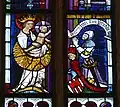
|
unknown | 1354 – 1407 or 1408 | 1407 or 1408[14] | Montfort-Tettnang |
|
|
| Henry V | 
|
unknown | c. 1380 – 1395 | c. 1395 | Montfort-Tettnang | Anna of Waldburg one child |
Son of Henry I, co-ruled with his father, predeceasing him. |
| Conrad | unknown | 1373 or 1374 – 1393 | 1393 | Montfort-Bregenz | Agnes of Montfort-Feldkirch two children |
Son of William II, co-ruled with his father, predeceasing him. Through his marriage became son-in-law of Hugo VI. | |
| Hugo VIII | 1357 | 1373 or 1374 – 1423 | 4 April 1423 | Montfort-Pfannberg |
|
Son of William III, inherited Montfort. He was also a minnesinger (troubadour). | |
| Ulrich IV | unknown | c. 1390 – 1410? | c. 1410? | Montfort-Pfannberg | Judith of Stadeck before 1410 two children |
Son of Hugo VIII, co-ruled with his father, predeceasing him. | |
| Rudolph V the Younger | unknown | 1375 | 16 November 1390 | Montfort-Feldkirch | Unmarried | In 1375 sold the county to the Habsburgs. | |
| In 1375, Feldkirch was sold to the Archduchy of Austria | |||||||
| William IV | unknown | 1393–1422 | 1422 | Montfort-Bregenz | Kunigunde of Toggenburg September/October 1387[15] one child |
||
| William V | 
|
unknown | 1408–1439 | 1439 | Montfort-Tettnang | Kunigunde of Werdenberg-Bludenz one child |
Sons of Henry I, ruled jointly. After William's death, his sons divided the land into Tettnang, Werdenberg and Rothenfels. |
| Rudolph VI | unknown | 1408–1425 | 8 December 1425 | Montfort-Tettnang | Unmarried | ||
| John I | unknown | 1425 – c. 1431 | c. 1431 | Montfort-Tettnang | Probably co-ruled with his father after the death of his uncle Rudolph. | ||
| Elisabeth | 
|
unknown | 1422–1443 | 4 June 1458 | Montfort-Bregenz |
|
Last countess of Bregenz. In 1443 she sold the county to Austria. |
| In 1443 Bregenz was sold to the Archduchy of Austria | |||||||
| Stephen | After 1401 | 1423–1437 | 14 or 27 August 1437 | Montfort-Pfannberg | Unmarried | Ruled jointly. Stephen was an uncle of Herman I, who was son of Ulrich IV. | |
| Herman I | unknown | 1423 – 1434 or 1435 | 22 January 1434 or 24 July 1435 | Montfort-Pfannberg | Margareta of Celje 15 March 1430 four children[16] | ||
| Herman II | unknown | 1437–1482 | 1482 | Montfort-Pfannberg | Cecilia of Liechtenstein-Murau 1462 five children |
Sons of Herman I, ruled jointly. | |
| John II | unknown | 1437–1469 | April 1469 | Montfort-Pfannberg | A woman from the Sternberg family no children | ||
| George I | unknown | 1437–1447 | 1447 | Montfort-Pfannberg | Unmarried | ||
| Ulrich V the Elder | unknown | 1439–1495 | 29 September 1495 | Montfort-Tettnang | Ursula of Hachberg 1467 one child |
Sons of William V, ruled jointly. | |
| Rudolph VII | unknown | 1439–1445 | 11 December 1445 | Montfort-Tettnang | Beatrice of Helfenstein no children | ||
| Henry VI | 1439–1444 | 23 November 1444 | Montfort-Werdenberg | Unknown one child |
Son of William V, inherited Werdenberg. | ||
| Hugo IX | 1439–1491 | 16 October 1491 | Montfort-Rothenfels |
|
Son of William V, inherited Rothenfels. | ||
| William VI | unknown | 1444–1483 | 5 February 1483 | Montfort-Werdenberg | Clementia von Hewen two children |
Left no descendants. Werdenberg merged in Rothenfels. | |
| In 1483 Werdenberg was annexed by Rothenfels. | |||||||
| In 1482 half of Bregenz was recovered by Hugo, son of Herman II. | |||||||
| Hugo X | 
|
unknown | 1482–1525 | 1550 | Montfort-Bregenz | Veronica of Waldburg no children |
Son of Herman II, bought half of Bregenz for himself, just to sell it once more in 1525. |
| In 1525 the half of Bregenz was sold again to the Archduchy of Austria. | |||||||
| George II | unknown | 1482–1544 | March or 30 May 1544 | Montfort-Pfannberg (1482–1524) Montfort-Peggau (1524–1544) |
Catherine of Poland after 1522 one child |
Sons of Herman II, ruled jointly. John was a canon in Salzburg. | |
| Herman III | unknown | 1482–1515 | 1515 | Montfort-Pfannberg | Unmarried | ||
| John III | unknown | 1482–1483 | c. 1483 | Montfort-Pfannberg | |||
| John IV | unknown | 1491–1529 | 19 September 1529 | Montfort-Rothenfels |
|
Half-brothers, ruled jointly. John and his full brothers, Ulrich (who became Knight Hospitaller) and Henry (who became canon at Augsburg and Strasbourg) left no descendants and were succeeded by his nephews, sons of Hugo XI, their half-brother. | |
| Ulrich VI | unknown | 1491–1520 | 16 April 1520 | Montfort-Rothenfels | Unmarried | ||
| Henry VII | unknown | 1491–1512 | 12 January 1512 | Montfort-Rothenfels | Unmarried | ||
| Hugo XI | unknown | 1491–1519 | 24 April 1519 | Montfort-Rothenfels | Anna of the Palatinate-Zweibrücken-Bitsch four children | ||
| Ulrich VII The Younger | 
|
Before 1439 | 1495–1520 | 23 April 1520 | Montfort-Tettnang | Magdalena of Oettingen 24 February 1485 no children |
Left no surviving descendants. Tettnang merged in Rothenfels. |
| William VII | c. 1485 | 1495–1509 | 8 January 1509 | Montfort-Tettnang | Unmarried | Co-ruled with his father, but predeceased him. | |
| In 1520 Tettnang was annexed by Rothenfels. | |||||||
| Hugo XII | 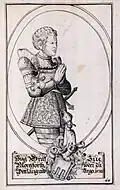
|
c. 1500 | 1529–1564 | 21 November 1564 | Montfort-Rothenfels | Maria Magdalena of Schwarzenberg before 1543 six children |
Sons of Hugo XI, ruled jointly. |
| John V (II)[17] | 
|
c. 1490 | 1529–1547 | 1547 | Montfort-Rothenfels | Jeanne d'Arenberg c. 1535 no children | |
| Wolfgang I | .png)
|
unknown | 1529–1541 | 21 March 1541 | Montfort-Rothenfels | Eleonore of Wolfstein before 1523 no children | |
| Jacob | c. 1530 | 1544–1573 | 3 May 1572[18] | Montfort-Peggau | Katharina Fugger 9 February 1553 five children[18] |
||
| Ulrich VIII | 1564–1575 | 6 April 1575 | Montfort-Rothenfels | Ursula of Solms-Lich 1559 two children |
After his death, the county was annexed by the Barony of Konigsegg, depriving Ulrich's sons from succession. | ||
| In 1575 Rothenfels was annexed by the Barony of Königsegg. | |||||||
| John VI[19] | c. 1557 | 1573–1619 | 21 February 1619[19] | Montfort-Peggau | Sybilla Fugger 4 October 1587 Augsburg three children[19] |
Sons of Jacob, ruled jointly.[20] | |
| Wolfgang II | unknown | 1573–1596 | 1596 | Montfort-Peggau | Unmarried | ||
| George III | unknown | 1573–1590 | 1590 | Montfort-Peggau | Anna von Lobkowicz 1584 no children[21] | ||
| Anton I | unknown | 1573–1592? | 1595[22] | Montfort-Peggau | Unmarried? | ||
| Hugo XIII | 1 April 1599[23] | 1619–1662 | 2 July 1662 | Montfort-Peggau | Johanna Euphroysne of Waldburg 7 October 1618 Wolfegg four children[23] |
Sons of John VI, ruled jointly. | |
| Herman IV | unknown | 1619–1641 | 1641 | Montfort-Peggau | Unmarried | ||
| John VII[24] | unknown | 1619–1623 | 1623 | Montfort-Peggau | |||
| Anton II the Elder | 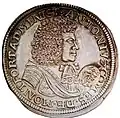
|
14 October 1635[25] | 1662–1706 | 15 June 1706[25] | Montfort-Peggau | Maria Victoria of Spauer-Flavon 1670 two children[25] |
Sons of Hugo XIII, ruled jointly. |
| John VIII[26] | 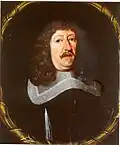
|
25 November 1627[26] | 1662–1686 | 12 September 1686[26] | Montfort-Peggau |
| |
| Anton III | 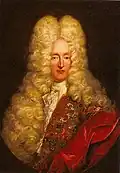
|
26 November 1670[28] | 1706–1733 | 17 December 1733[28] | Montfort-Peggau | Maria Anna of Thun-Hohenstein 16 May 1693 two children[28] |
Anton III, son of John VIII, shared rule with his cousin Sebastian, son of Anton II. |
| Sebastian | 7 October 1684[29] | 1706–1728 | 6 February 1728[29] | Montfort-Peggau | Unmarried | ||
| Maximilian Joseph Ernest | 
|
20 January 1700[30] | 1733–1759 | 17 March 1759[30] | Montfort-Peggau | Maria Antonia of Waldburg 26 January 1722 one child[30] |
Son of Anton II. |
| Francis Xavier | 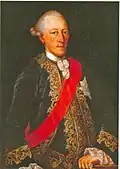
|
3 November 1722[31] | 1759–1780 | 24 March 1780[31] | Montfort-Peggau | Sophia Theresa Maximiliane of Limburg-Bronkhorst 1 December 1758 no children[31] |
After his death the county was sold to Austria. |
| In 1780, Pfannberg was sold to the Archduchy of Austria | |||||||
Prince of Montfort
.svg.png)
In 1810, the Tettnang territory was adjudicated to the Kingdom of Württemberg. In 1816, King Frederick I vested his daughter Catharina and her husband Jérôme Bonaparte with the titles of Princess and Prince of Montfort (French: prince de Montfort).[32] This princely title continued in the family by descent.[33]
See also
Sources
- Burmeister, Karl Heinz: Montfort, von (Grafen von Montfort), Familienartikel in: Neue Deutsche Biographie, Bd. 18, S. 51-54
- Burmeister, Karl Heinz: Die Grafen von Montfort. Geschichte, Recht, Kultur. Festgabe zum 60. Geburtstag, hrsg. von Alois Niederstätter (= Forschungen zur Geschichte Vorarlbergs; NF 2). Universitätsverlag Konstanz, Konstanz 1996, ISBN 3-87940-560-3
- Burmeister, Karl Heinz; Kuhn, Elmar L., Moser, Eva u.a.: Die Grafen von Montfort. Geschichte und Kultur. (= Kunst am See; Band 8). Gessler, Friedrichshafen 1982, ISBN 3-922137-16-4
References
- ^ Stälin, C. F. (1847). Wirtembergische Geschichte (Stuttgart, Tübingen), Part II, p. 448.
- ^ MGH Necrologia Germaniæ, Vol. I, p. 644.
- ^ MGH Necrologia Germaniæ, Band I, p. 147.
- ^ This count Henry is officially known as III, albeit the fact that there's no known Henry II in the family tree of the Montforts. In fact he is from the generation that immediately follows the one where Henry I belongs.
- ^ MGH Necrologia Germaniæ, Band I, p. 150.
- ^ Vorarlberg Chronik
- ^ He was already dead by 7 October 1310, according to Vanotti (1845), 12, p. 544.
- ^ Living in a document dated 6 February 1348, but already dead on another of 3 November 1353, according to Vanotti (1845), 19, p. 552 and Vanotti (1845), 20, p. 553.
- ^ His daughter Anna renounced her paternal inheritance in a document dated 6 June 1375, according to Vanotti (1845), Anhang, 94, p. 485.
- ^ Mentioned in a charter dated 23 June 1360, according to Bergmann, Grafen von Montfort (1848), Heft III, XXXII, p. 79.
- ^ Referenced as living in a charter dated 8 April 1362, according to Fink (2016), p. 154.
- ^ They are referred as married by a document dated 16 June 1373, according to Tangl, K. Die Grafen von Pfannberg, Archiv für Kunde österreichischer Geschichts-Quellen, Band XVIII (Vienna, 1857), 230, p. 196.
- ^ They are referred as married by a document dated 1367, according to Vanotti (1845), Anhang, 86, p. 483.
- ^ Referenced as dead in a document of his sons, dated 18 October 1408, according to Vanotti (1845), 34, p. 578.
- ^ Contract of marriage dated 29 September 1387, according to Vanotti (1845), Anhang, 122, p. 488.
- ^ Herman I. von Montfort
- ^ Known sometimes as John II: Graf Johann II. von Montfort-Rothenfels (ca. 1490–1547)
- ^ a b Jakob von Montfort
- ^ a b c Johann VI. von Montfort
- ^ They're attested in 1592: Geschichte der Grafen von Montfort und von Werdenberg
- ^ Georg III von Montfort
- ^ Anton von Montfort
- ^ a b Hugo XV. von Montfort
- ^ Johann VII von Montfort
- ^ a b c Johann Anton I van Montfort Tettnang
- ^ a b c Johann VIII. von Montfort
- ^ Johann VIII. von Montfort
- ^ a b c Anton II van Montfort Tettnang
- ^ a b Sebastian van Montfort Tettnang
- ^ a b c Maximilian Joseph Ernst van Montfort Tettnang
- ^ a b c Franz Xavier van Montfort Tettnang
- ^ Antoine-Vincent Arnault; Antoine Jay; Étienne de Jouy; Jacques Marquet de Norvins (1821). Biographie nouvelle des contemporains (in French). Paris: Librairie historique. p. 239.
- ^ Gentleman's Magazine and Historical Review. London: Henry & Parker. 1860. p. 208.